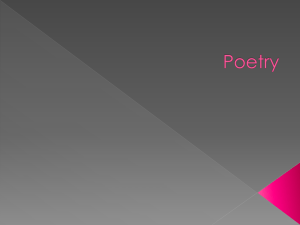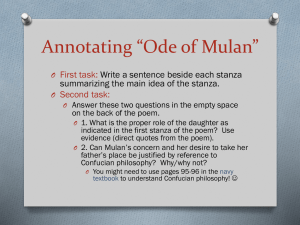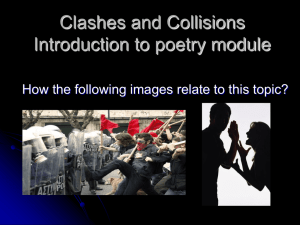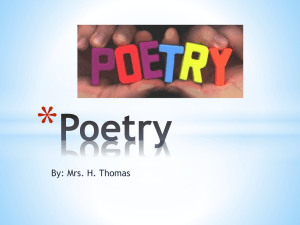File
advertisement
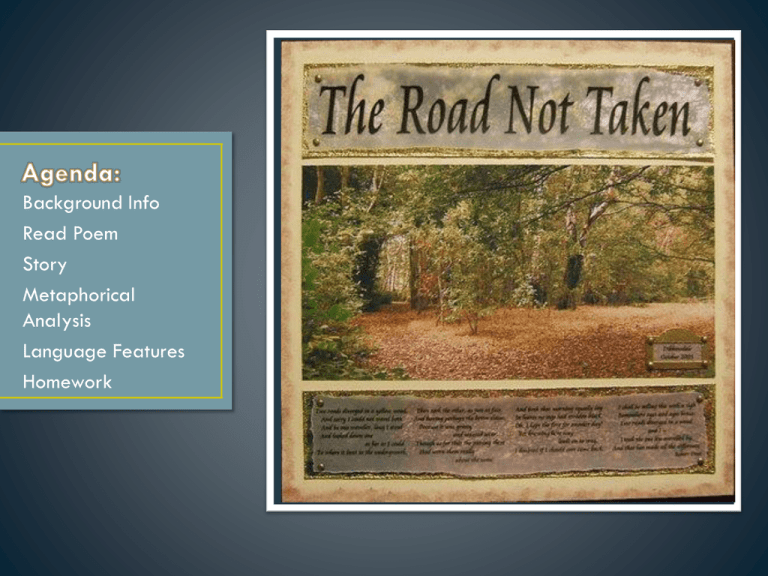
Background Info Read Poem Story Metaphorical Analysis Language Features Homework By Robert Frost • Author: Robert Frost • One of the most famous and well-loved American poets • Frost’s crowning public moment was his recitation of “The Gift Outright” at John F. Kennedy’s inauguration in January of 1960 • Date: 1921 • Setting: New England, USA • Characters: “I-narrator” • Point of View: first person (see above) • What is the story? • • • • • • • • Form Purpose Audience Tone Narrative Voice (look at your notes) Characters (look at your notes) Setting (look at your notes) Title • As with most poems, there are many ways to interpret the story. #1, Literal: a traveller picking a path through the woods The speaker stands in the woods, considering a fork in the road. Both ways are equally worn and equally overlaid with un-trodden leaves. The speaker chooses one, telling himself that he will take the other another day. Yet he knows it is unlikely that he will have the opportunity to do so. And he admits that someday in the future he will recreate the scene with a slight twist: He will claim that he took the less-travelled road. #2, Metaphorical: the story is a metaphor for an individual choosing a path in life. Let’s look more closely at this interpretation. Then took the other, as just as fair And having perhaps the better claim, Because it was grassy and wanted wear; Though as for that, the passing there Had worn them really about the same, The decision was made upon the smallest of differences. Suggests, once again, that our decisions are arbitrary. 1. Implies that there can be little outward indication of the consequences of our choices. 2. Little to no difference between the two choices. Identifies the struggle and uncertainty that can surround the choices one if forced to make in life. He is not really sure that he has made the right decision—he will never know for sure. Seems to say one choice is better than the other. He seems to contradict himself. Shows the confusion he feels—the ambivalence he feels as he is confronted with choice. No difference, once again. And both that morning equally lay In leaves no step had trodden black. Oh, I kept the first for another day! Yet knowing how way leads on to way, I doubted if I should ever come back. This contradicts the previous stanza as the paths have suffered no wear and the leaves are fresh. This communicates a sense of excitement to the responder— this particular journey is unique. What is a Stanza? Naivete/optimism that the traveller could return to this point to take the first path. Excitement, or trying to convince himself. Contradicts the previous line and suggest the incremental, cumulative nature of life’s journey that cannot be retracted or undone. I shall be telling this with a sigh Somewhere ages and ages hence: Two roads diverged in a wood and I— I took the one less traveled by, And that has made all the difference Reinforces a sense of loss. Sense of the circular nature of journeys in that difference decision points in the process of journeying are revisited. Repetition: the sense that there will be plenty of time after the choices he makes and that much of his life still lies before him. What does that contracdict? Repetition: of the frist line. Reflective comment bookends the poem. Definitive: change in tone. Did they make all the difference Is he trying to convince himself again? Or, is it the act of making a decision that is most important thing? What were the other options? He could’ve stayed there at the fork. He could’ve chosen the first path. Is it the path he took that made all the difference, or just that he took any path? • Repetition • Metaphor • Imagery • Rhythm • Rhyme Scheme • Onomatopoeia The rhythm of the poem is irregular—there is no fixed beat. Conversational. Reflects the uncertainty of the poem’s content. The Rhyme Scheme is very regular. ABAAB in every stanza. Maybe hidden under life’s apparent randomness is an underlying pattern—a structure that carries us forward and directs us. Does that make our choices less important?
